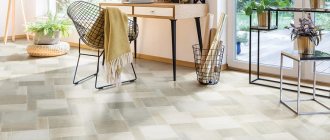For more than 20 years, in many kitchens you can see elegant railing systems, often replacing bulky wall and drying cabinets, and sometimes functioning in conjunction with them.
At first, roof rails seemed exotic, accessible only to people with high incomes, and then gradually became an ordinary element of kitchen design.
What are roof rails, what types they are, how to choose and install them correctly - you will learn about this in this article.
Advantages and disadvantages
Hanging a roof rail in the kitchen is a simple matter, but first of all you need to weigh the pros and cons.
| pros | Minuses |
|
|
Disadvantages of open storage of items.
All objects are in plain sight, which creates a feeling of disorder. Do not overload the pipe with utensils, leaving only truly necessary things. It is desirable that the items placed on the railing be designed in the same style.
Over time, a greasy coating appears on the roof railing, which is removed with special detergents.
Large items, such as frying pans and pots, are not placed on the railing; they are stored in closed cabinets.
Kitchen layout options
Rails can be placed in three ways:
- Horizontal. The classic type of railing system, when the pipe is attached between the countertop and the upper kitchen cabinets. Hooks, baskets, shelves and other accessories are hung on it. To make the most of space, arrange your kitchen rails in several rows on an empty wall.
The photo shows an example of a combination of roof rails and shelves
- Vertical. The pipe is installed vertically from the tabletop to the ceiling, and shelves and baskets are attached to it at a distance from each other. Most often used for bar counters and peninsulas. But this design will fit no less perfectly into the free corner of the kitchen set.
The photo shows roof rails for a kitchen in an interior with a bar counter
- Suspension. Based on the name, you can guess that the railing system hangs from the ceiling. It looks most impressive above the island - suitable for organizing the storage of pans and cutting boards. Or above the bar counter - for glasses, shot glasses and even bottles.
Hanging system for storing pans
Undeniable advantages
The railing system first appeared in restaurant kitchens, where, in order to save time and work space, they were looking for a way to conveniently and easily accessible the placement of frequently used devices. This is the main advantage - ergonomics, which means there is no need to search for a spatula or ladle in numerous drawers.
The innovation also has the following useful qualities:
- Possibility of installation anywhere;
- Ease of installation;
- The versatility of metal, fits into any style interior;
- Acceptable price;
- Easy installation and dismantling;
- Mobility;
- Strength and durability of the structure;
- A wide range of configurations allows you to experiment and create the most convenient workplace.
What can you hang on the railing?
A pipe on the wall alone will not add functionality to your kitchen. The most important thing is the mounted modules, which are selected depending on everyone’s personal preferences.
Let's look at the main pendant options:
Hook. The simplest and most cost-effective, yet effective filling. You can hang various ladles, spatulas, towels, potholders, frying pans, stewpans and much more on them.
Shelf. Depending on the size and depth, they store everything from detergents and sponges to jars of sauces and seasonings.
Basket. The high edges make it safer than a shelf and better suited for tall bottles and cans.
Cup. Not all kitchen utensils have holes and hooks, having a glass will solve this problem - just put cutlery, spatulas and other things in it.
The photo shows an option for open storage of utensils
Dryer. They are used both for temporary arrangement of dishes after washing, and for permanent storage of the main set of plates and mugs.
Holder. Special designs are developed for:
- paper towels;
- foil, baking paper and film;
- pots and pans;
- lids; cookbooks and tablets;
- cutting boards;
- knives; mugs and glasses;
- small household appliances.
Magnet. Usually used for storing knives, but you can place anything: iron jars for spices, flowerpots and containers.
Jar. Suitable for horizontal railing system. Thanks to the hook-shaped lid, it fits directly on the tube without additional shelves. Because The jars are small and spices are usually poured into them.
The photo shows wooden hanging holders
Useful tips
There is a simple rule to remember. Convenient fixtures only complement furniture and do not replace it. Therefore, it is necessary to be guided by measure. Excessive use of accessories for storing utensils can overload the room. And instead of a sense of order, you can achieve the opposite effect.
A large number of roof rails in one room Source equ.anandasoulcreations.com
To make roof rails look practical and attractive, you need to:
- Calculate the required number of hooks and holders.
- Consider the location of each item. For example, a shelf with a washcloth and detergent is needed near the sink, and it is better to place spices closer to the stove.
- Since the kitchen is considered a complex operational space, the structure must be made of high-quality materials.
- The location of the railing should be such that it is possible to reach it without taking extra steps.
- If the structures are metal, then they must be combined with furniture fittings.
Experts also advise using only a couple of small structures rather than covering the entire kitchen area with holders. This will avoid the illusion of chaos, and the interior will not suffer from overload.
How to create a railing system for yourself?
When installing roof rails, the rule “more is better” does not work. Therefore, you should not buy all possible accessories for the railing system and try to find a use for them.
It would be more correct to do the opposite: observe your behavior during cooking and eating, as well as cleaning. What items and products do you use most often? Ideally, attach to the railing something that is used every 1-5 days.
To test the theory, make a mock-up of the future structure directly on the wall using masking tape. This way you will understand whether you have enough space and what is missing.
The photo shows a minimalist interior with a metal dryer
The equipment also depends on your kitchen:
- In small rooms, store only the essentials on the railing; a lot of items will create a feeling of chaos.
- In a spacious kitchen, install a long pipe, placing accessories at a distance from each other.
- In a set with a corner sink, dish soap and a sponge are placed on a hanging shelf.
- In a kitchen with a free surface in the corner there is a place for a vertical rail.
Installation Features
Installing the tube fastening is similar to installing a cornice. But before you start, you should decide on the location. Typically, the railing is located above the work area, sink or stove.
At what height should the railing be hung?
Horizontal railing
The optimal height of the railing in the kitchen above the countertop is 45-50 cm. Most often it is attached to the apron.
If you do not have upper cabinets, the railing can also hang above the apron - 60 cm from the work area. If there are cabinets, when marking, step back from them at least 10 cm downwards. With a smaller distance, it will be inconvenient to remove the mounts and use accessories.
Another important parameter is the load on the pipe. To prevent it from sagging, install the holders no more than 0.5 m from each other. Not all manufacturers include enough parts in the kit, so additional supports will have to be purchased separately.
Vertical railing
Shelves and baskets with essentials should be no higher than the outstretched arm of the shortest family member. The space under the ceiling is used to place indoor flowers and decorative elements.
Hanging railing
Place it in such a way that the hostess can reach the placed items and take them without standing on the stool.
How to install a roof rail in the kitchen: step-by-step instructions
Installation of a horizontal system
Based on your preferences, you can choose a single long rail along the entire kitchen wall or short individual sections in the main activity areas. Horizontal rails are placed not only on the wall or apron, they can be hidden in cabinets, attached to the end of the kitchen unit, or even on the door.
Before installing roof rails in the kitchen, let’s look at the design of the system. It includes the tube itself, a pair of plugs and holders. The latter act as brackets. If you are going to install roof rails in the kitchen on 2 adjacent walls, you can purchase corner adapters - this way you will connect both parts into a single composition. To connect a straight long tube, a coupling is useful.
To mount the system on the wall you will need:
- level;
- roulette;
- pencil;
- screwdriver;
- hammer;
- self-tapping dowels;
- impact drill or hammer drill.
Let's start installation:
- Mark the location of the future railing using a tape measure, level and pencil.
- Mark the holes for the brackets, placing them at a maximum distance of 50 cm from each other.
- Drill holes and hammer plastic dowels into them.
- Insert the self-tapping screw into the sleeve (comes with the railing) and secure it to the wall.
- Place the holder on the sleeve; it is secured with screws.
- Insert the tube into the holes of the holders so that the ends come out from both sides at the same distance.
- Secure the tube in the supports with screws.
- Install plugs along the edges of the pipe.
For more detailed installation instructions, see the video:
Installation of a vertical system
Vertical railing can be of 2 types: with spacers and without them. In the first case, the installation is similar to installing a crossbar for a curtain in a bathroom - you don’t have to drill anything, just follow the instructions.
If there are no spacers, prepare the same tools as for a horizontal structure and proceed:
- Mark mounting holes on the bottom (table top or floor) and top (ceiling) parts.
- Drill holes and hammer dowels into the floor and ceiling.
- Secure the holders at the bottom and top using self-tapping screws.
Installation of suspension system
Installing a hanging rail is different from the first two, but you will need the same tools: tape measure and pencil, hammer drill, wrench. The main difference in fasteners: the use of anchor bolts in the form of a hook. And the system itself is suspended on chains on them.
- Mark holes for anchor hooks.
- Drill in the right places along the diameter of the sleeve and clean it well from dust.
- Insert the hook into the hole and tighten it tightly with a wrench.
- Hang the chains on the hooks and the railing on them.
Materials for production
The most popular type of railing is stainless steel pipe. It can withstand heavy loads, is not subject to corrosion, looks stylish and is easy to maintain. Depending on the interior of the kitchen, steel rails are tinted bronze, gold, brass or painted in different colors. Spraying also performs a protective function against moisture and corrosion.
Anodized aluminum is also popular, but it does not withstand heavy loads. Such railings are mounted in short sections in the work area or for placing decorative items.
There are also designer models. They perform an aesthetic function and complete the interior of the kitchen. They are made from polymers, wood, and even plexiglass with built-in lighting.
Photos in the interior
We have already said that the railing system suits any interior style, the main thing is to choose the right color and content.
Rails in a classic kitchen are most often platinum or gold. They hang beautiful potholders or towels, skimmers and ladles from one set, and put spices.
Flowers on the railings in the kitchen in minimalist flowerpots will appeal to fans of the Scandinavian style. In a white kitchen, black rails that echo the furniture handles will look best.
Copper, brass and bronze will look great in a loft style. Store frying pans, wooden cutting boards and other interesting utensils on them.
If you love modernity, hi-tech or minimalism, choose chrome models. There is no need to skimp on attachments - instead of simple round pipes, install stylish flat strips.
The photo shows a modern kitchen with unusual storage
And finally, some important tips on how to place roof rails for the kitchen:
- Towels, a shelf with household chemicals, and a dish dryer are hung near the sink;
- At the stove you will need oven mitts, ladle and spatulas, spices, sauces and oil;
- cutting boards and knives will be useful in the food preparation area;
- A glass holder and a wine shelf would look appropriate above the bar counter;
- for ease of use of books with recipes, a special shelf with a clip is useful;
- A holder with a serrated edge makes it easier to tear off foil, parchment paper and cling film;
- Storing lids on roof rails in the kitchen will save you from the problem of their inconvenient placement in the closet.











